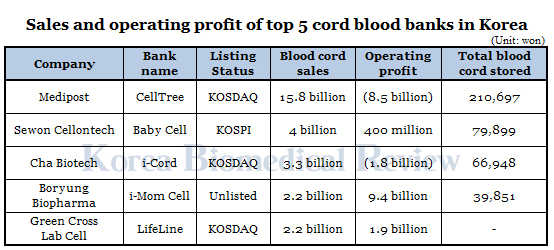Korean celebrity couples, such as Ko So-young and Jang Dong-gun, Ki Sung-yueng and Han Hye-jin, and Rain and Kim Tae-hee, have renewed public attention to cord blood banks, by storing the blood from their baby’s umbilical cord after birth.
Often heralded as a form of “biological insurance” against future diseases, cord blood contains hematopoietic stem cells that can be used to treat more than 80 types of illnesses, including cancer, blood diseases, and immune system disorders.
Research shows blood from the umbilical cord has ten times more stem cells than those from the bone marrow and rarely carry any infectious diseases. Cord fluid used to be thrown away at birth but many parents store the blood for possible future use by the child.
Doctors can retrieve cord blood in a relatively simple process by clamping the umbilical cord in two places around 10 inches apart, cutting it, and then insert a needle to collect the fluid. The process takes a few minutes in all. The blood is then sealed in a bag and sent to a laboratory or a cord blood bank for testing and storage.

Currently, there are 17 authorized cord blood banks in Korea. They are either a public donation or private family bank with some being a combination of the two.
Public donation banks do not charge any fees and store cord blood for general use and research. Donors may register with an authorized blood cord bank and donate their cord blood free of charge.
Family, or private, banks, store cord blood for use by the donor and family members only. Although each bank charges a different amount, it usually costs around 80,000 won ($71) a year or about 1 million won for 15 years.
Of the approved family banks, Medipost’s CellTree ranks number one domestically. It recorded 15.8 billion won in sales and had over 200,000 blood cords saved as of 2016, according to data compiled by Cord Blood Korea.

Medipost announced two months ago that the sales of its umbilical cord blood division, its flagship unit, rose 18.5 percent year-to-year and its stem cell treatment business grew by 83.4 percent from last year, hitting record sales in the second quarter of this year.
The popularity of blood cord banks dipped notably after 2015 when local reports showed the misuse and abuse of blood cords by these banks. According to the Ministry of Health and Welfare, certain banks violated obligations to report cord blood supply according to existing regulations. Some had also used and gave away “unqualified” cord blood for research without proper reporting and stored the fluid without consent, the ministry said.
In July, the health ministry responded by saying it will take corrective actions to strengthen and enforce compliance, including mandating registry of subpar umbilical cord blood and allowing banks to store these unqualified cord blood for research properly while enhancing punitive measures of unauthorized sale or provision of cord blood to research institutes.

